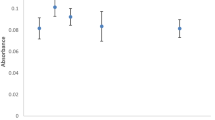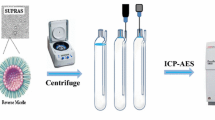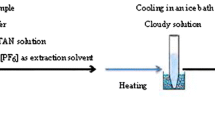Abstract
In this study, a ternary Zr(IV) system with 2-(5-bromo-2-pyridylazo)-5-diethylaminophenol (5-Br-PADAP) and fluoride was chosen on the basis of dispersive liquid–liquid microextraction method. Zirconium was extracted into the fine droplets of dichlorobenzene as extracting solvent. These drops dispersed as a cloud in the aqueous sample with the help of ultrasonic waves, and the procedure was done. Finally, atomic absorption spectrometry was applied for the determination of zirconium. The effects of different factors that influence complex formation and extraction, such as pH, amounts of complexing agents, type and volume of the extracting solvent, as well as sonication and centrifuging time, were optimized. Under optimum conditions, the calibration curve was linear in the range of 150.0–800.0 ng mL−1 with a limit of detection of 44.0 ng mL−1. Relative standard deviation was calculated to be 4.1 % (n = 7, c = 400.0 ng mL−1). The enrichment factor was 80. The proposed method was successfully used to determine the zirconium in several water, wastewater, and soil samples.




Similar content being viewed by others
References
Abbaspour, A., & Baramakeh, L. (2002). Simultaneous determination of zirconium and molybdenum by first-derivative spectrophotometry. Analytical Sciences, 18, 1127–1130.
Arida, H. A. (2008). Novel PVC membrane-based thoron ion selective electrode and its application: determination of zirconium. Talanta, 76, 40–43.
Bassan, M. K. T., Sharma, P. K., & Singhal, R. K. (2010). Low cost and rapid analytical technique for determination of niobium and titanium in zirconium alloy. Analytical Methods, 2, 1559–1564.
Busev, A. I., Tiptsova, V. G., & Ivanov, V. M. (1978). Analytical chemistry of rare elements (p. 157). Moscow: Mir Publishers.
Chartier, F., Isnard, H., Degros, J. P., Faure, A. L., & Frechou, C. (2008). Application of the isotope dilution technique for Zr determination in an irradiated cladding material by multiple collector-inductively coupled plasma mass spectrometry. International Journal of Mass Spectrometry, 270, 127–133.
de Jager, L. S., & Andrews, A. R. J. (2001). Development of a screening method for cocaine and cocaine metabolites in urine using solvent microextraction in conjunction with gas chromatography. Journal of Chromatography. A, 911, 97–105.
Ells, C. E., Coleman, C. E., & Chow, C. K. (1985). Properties of a CANDU calandria tube. Canadian Metallurgical Quarterly, 24, 215–223.
El-Sayed, A. A., Hamed, M. M., & El-Reefy, S. A. (2010). Determination of micro-amounts of zirconium in mixed aqueous organic medium by normal and first-derivative spectrophotometry. Journal of Analytical Chemistry, 65, 1113–1117.
Faghihian, H., & Kabiri-Tadi, M. A. (2010). novel solid-phase extraction method for separation and preconcentration of zirconium. Microchimica Acta, 168, 147–152.
Fathirad, F., Afzali, D., Mostafavia, A., & Ghanbarian, M. (2012). Ultrasound-assisted emulsification solidified floating organic drops microextraction of ultra trace amount of Te (IV) prior to graphite furnace atomic absorption spectrometry determination. Talanta, 88, 759–764.
Ghasemi, J. B., & Zolfonoun, E. (2010). Simultaneous spectrophotometric determination of trace amounts of uranium, thorium, and zirconium using the partial least squares method after their preconcentration by alpha-benzoin oxime modified Amberlite XAD-2000 resin. Talanta, 80, 1191–1197.
Gupta, V. K., Goyal, R. N., & Sharma, R. A. (2009). Novel PVC membrane based alizarin sensor and its application; determination of vanadium, zirconium and molybdenum. International Journal of Electrochemical Science, 4, 156–172.
Hedrick, J. B. (2000). Minerals yearbook (p. 87). Washington, DC: US Geological Survey.
Lajuen, L. H. J. (1992). Spectrochemical analysis of atomic absorption and emission. London: Royal Society of Chemistry.
Lee, C. H., Suh, M. Y., Choi, K. S., Kim, J. S., Park, Y. J., & Kim, W. H. (2003). Determination of Ru, Rh, Pd, Te, Mo and Zr in spent pressurized water reactor fuels by ion exchange and extraction chromatographic separations and inductively coupled plasma atomic emission spectrometric analysis. Analytica Chimica Acta, 475, 171–179.
Loh, H. C., Ng, S. M., Ahmad, M., & Taib, M. N. (2005). Accurate zirconium detecting at visible wave length using artificial neural network. Analytical Letters, 38, 1305–1316.
Molaakbari, E., Mostafavi, A., & Afzali, D. (2011). Ionic liquid ultrasound assisted dispersive liquid–liquid microextraction method for preconcentration of trace amounts of rhodium prior to flame atomic absorption spectrometry determination. Journal of Hazardous Materials, 185, 647–652.
Oszwałdowski, S., & Jakubowska, J. (2003). Simultaneous determination of zirconium and hafnium as ternary complexes with 5-Br-PADAP and fluoride using solid-phase extraction and reversed-phase liquid chromatography. Talanta, 60, 643–652.
Oszwaodowski, S., Lipka, R., & Jarosz, M. (1998). Simultaneous determination of zirconium and hafnium as ternary complexes with 2-(5-bromo-2-pyridylazo)-5-diethylaminophenol and fluoride by reversed-phase liquid chromatography. Analytica Chimica Acta, 361, 177–187.
Psillakis, E., & Kalogerakis, N. (2002). Developments in single-drop microextraction. TRAC Trends in Analytical Chemistry, 21, 53–63.
Rezaee, M., Assadi, Y., Milani Hosseini, M. R., Aghaee, E., Ahmadi, F., & Berijani, S. (2006). Determination of organic compounds in water using dispersive liquid-liquid microextraction. Journal of Chromatogrphy A, 1116, 1–9.
Rezaee, M., Yamini, Y., & Khanchi, A. R. (2012). Extraction and separation of zirconium from hafnium using a new solvent microextraction technique. Journal of the Iranian Chemical Society, 9, 67–74.
Schenk, E. R., & Almirall, J. R. (2012). Elemental analysis of glass by laser ablation inductively coupled plasma optical emission spectrometry (LA-ICP-OES). Forensic Science International, 217(1–3), 222–228.
Shariati, S., & Yamini, Y. (2006). Cloud point extraction and simultaneous determination of zirconium and hafnium using ICP-OES. Journal of Colloid and Interface Science, 298, 419–425.
Shaw, T. J., Duncan, T., & Schnetger, B. (2003). A preconcentration/matrix reduction method for the analysis of rare earth elements in seawater and groundwaters by ID-ICP-MS. Analytical Chemistry, 75, 3396–3403.
Yang, X. J., Fane, A. G., & Pin, C. (2002). Separation of zirconium and hafnium using hollow fibers Part I. Supported liquid membranes. Chemical Engineering Journal, 88, 37–44.
Acknowledgments
We gratefully acknowledge the financial support provided for this project (no. 419110) by the Institute of Science and High Technology and Environmental Sciences, Graduate University of Advanced Technology, Kerman, Iran. This paper is dedicated to the memory of the founder of Kerman University, Alireza Afzalipour, on the occasion of the centennial of his birth.
Author information
Authors and Affiliations
Corresponding author
Rights and permissions
About this article
Cite this article
Afzali, D., Fathirad, F., Ghaseminezhad, S. et al. Determination of trace amounts of zirconium in real samples after microwave digestion and ternary complex dispersive liquid–liquid microextraction. Environ Monit Assess 186, 3523–3529 (2014). https://doi.org/10.1007/s10661-014-3635-7
Received:
Accepted:
Published:
Issue Date:
DOI: https://doi.org/10.1007/s10661-014-3635-7




